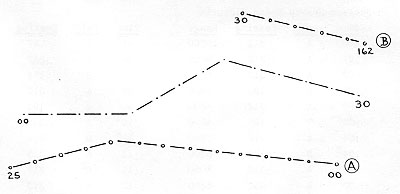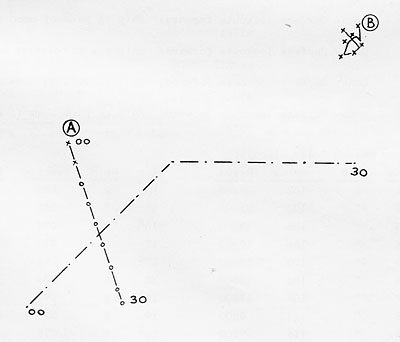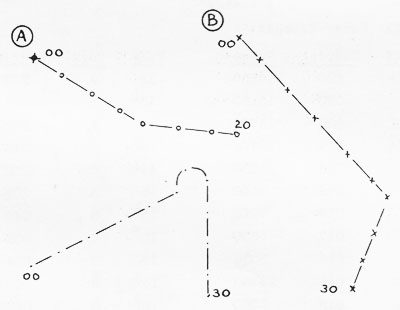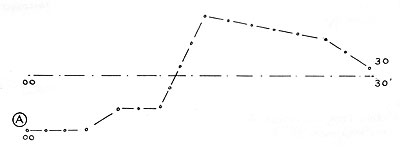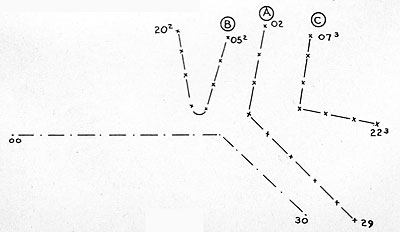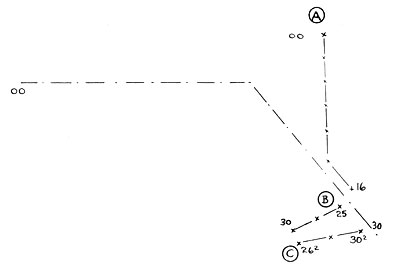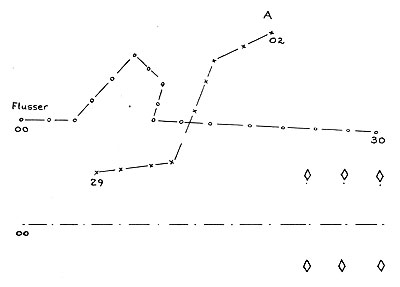Problem 2.
Own ship's initial course and speed: 100°(T), 18 knots.
Problem 3.
| Own ship's initial course and speed: 220°(T) 20 knots.
| TIME |
RAID |
BEARING |
RANGE |
|
TIME |
RAID |
BEARING |
RANGE |
| 00 |
Charlie |
272 |
9160 |
|
09 |
Charlie |
308 |
3420 |
| 01 |
" |
274 |
8460 |
|
10 |
" |
325 |
3140 |
| 02 |
" |
275 |
7800 |
|
11 |
" |
342 |
3100 |
| 03 |
" |
278 |
7240 |
|
12 |
ii. |
000 |
3380 |
| 04 |
" |
280 |
6600 |
|
122 |
(Own ship's course to 200°(T)). |
| 042 |
(Own ship's course to 230°(T)). |
|
13 |
Charlie |
008 |
3680 |
| |
|
|
|
14 |
" |
015 |
4400 |
| 05 |
Charlie |
283 |
5900 |
|
15 |
" |
018 |
5180 |
| 06 |
" |
286 |
5220 |
|
16 |
" |
024 |
6000 |
| 07 |
" |
290 |
4660 |
|
17 |
ii. |
025 |
6680 |
| 08 |
" |
295 |
4000 |
|
|
|
|
|
Problem 4.
Own ship's initial course and speed: 150° (T) 18 knots.
| TIME |
RAID |
BEARING |
RANGE |
|
TIME |
RAID |
BEARING |
RANGE |
| 00 |
Dog |
282 |
4040 |
|
10 |
Dog |
208 |
1600 |
| 01 |
" |
280 |
3720 |
|
102 |
(Own ship come to course 180° (T) 20 knots.) |
| 02 |
" |
280 |
3440 |
|
|
| 03 |
" |
278 |
3160 |
|
11 |
Dog |
186 |
1440 |
| 04 |
" |
275 |
2840 |
|
12 |
" |
165 |
1460 |
| 05 |
" |
272 |
2560 |
|
13 |
" |
148 |
1640 |
| 052 |
(Own ship slow to 10 kts.) |
|
14 |
" |
135 |
1900 |
| 06 |
Dog |
270 |
2300 |
|
15 |
" |
124 |
2360 |
| 07 |
" |
258 |
1900 |
|
16 |
" |
102 |
2820 |
| 08 |
" |
245 |
1640 |
|
17 |
" |
090 |
3600 |
| 09 |
" |
225 |
1600 |
|
18 |
" |
082 |
1180 |
| |
|
|
|
|
19 |
" |
075 |
5400 |
--A-6--
Problem. 5.
Own ship's initial course and speed: 080°(T) 12 knots.
| TIME |
RAID |
BEARING |
RANGE |
|
TIME |
RAID |
BEARING |
RANGE |
| 00 |
Easy |
058 |
19,000 |
|
092 |
Easy |
045 |
11,220 |
| 003 |
" |
056 |
18,400 |
|
103 |
" |
042 |
10,640 |
| 013 |
" |
051 |
17,600 |
|
113 |
" |
040 |
10,000 |
| 021 |
" |
055 |
17,200 |
|
122 |
" |
034 |
9,160 |
| 03 |
" |
051 |
16,600 |
|
13 |
" |
032 |
8,840 |
| 041 |
" |
052 |
15,600 |
|
132 |
(Own ship 's course to 080° (T.) |
| 05 |
" |
052 |
15,000 |
|
|
| 053 |
" |
050 |
14,200 |
|
14 |
Easy |
026 |
8,520 |
| 071 |
" |
048 |
13,000 |
|
152 |
" |
018 |
8,180 |
| 072 |
(Own ship 's course to 065°(T)). |
|
161 |
" |
014 |
8,000 |
| 081 |
Easy |
048 |
12,800 |
|
17 |
" |
010 |
8,000 |
| 09 |
" |
045 |
12,000 |
|
|
|
|
|
Problem 6.
(2 targets). Own ship's initial course and speed, 015°(T) 15 knots.
| TIME |
RAID |
BEARING |
RANGE |
|
TIME |
RAID |
BEARING |
RANGE |
| 00 |
Fox |
204 |
3720 |
|
|
|
|
|
| 01 |
" |
203 |
3600 |
|
|
|
|
|
| 02 |
" |
204 |
3500 |
|
|
|
|
|
| 03 |
" |
203 |
3420 |
|
|
|
|
|
| 04 |
" |
202 |
3320 |
|
|
|
|
|
| 05 |
" |
202 |
3200 |
|
052 |
Item |
348 |
3300 |
| 06 |
" |
202 |
3120 |
|
062 |
" |
344 |
2880 |
| 07 |
" |
200 |
3020 |
|
072 |
|
338 |
2500 |
| 08 |
" |
200 |
3520 |
|
082 |
" |
330 |
2200 |
| 09 |
" |
200 |
4000 |
|
092 |
" |
320 |
1820 |
| 10 |
" |
200 |
4480 |
|
102 |
Cease |
305 tracking |
1600 |
| (101 Own ship changes course to 320°(T)). |
| 11 |
Fox |
192 |
4820 |
|
|
|
|
|
| 12 |
" |
188 |
5140 |
|
|
|
|
|
| 13 |
|
182 |
5200 |
|
|
|
|
|
| 14 |
" |
178 |
5260 |
|
142 |
Item |
175 |
1500 |
| 15 |
" |
172 |
5400 |
|
|
|
|
|
| 16 |
|
166 |
5560 |
|
|
|
|
|
| 17 |
" |
162 |
5800 |
|
|
|
|
|
| 18 |
" |
158 |
6040 |
|
182 |
" |
155 |
3300 |
| 19 |
" |
155 |
6320 |
|
|
|
|
|
| 20 |
|
150 |
6580 |
|
|
|
|
|
--A-7--
Problem 7.
(2 targets). Own ship's course 060°(T), 12 knots.
| TIME |
RAID |
BEARING |
RANGE |
|
TIME |
RAID |
BEARING |
RANGE |
| 00 |
George |
150 |
8000 |
|
002 |
King |
031 |
7000 |
| 01 |
" |
150 |
8020 |
|
012 |
" |
034 |
6780 |
| 02 |
" |
150 |
8080 |
|
022 |
" |
036 |
6500 |
| 03 |
" |
150 |
8000 |
|
032 |
" |
040 |
6320 |
| 04 |
" |
150 |
8040 |
|
042 |
" |
042 |
6120 |
| 05 |
" |
150 |
7980 |
|
052 |
Hi |
045 |
5680 |
| 06 |
" |
150 |
8000 |
|
062 |
" |
048 |
5300 |
| 07 |
" |
150 |
8000 |
|
071 |
" |
051 |
4900 |
| (072 |
Own ship 's course change to 108°(T)). |
|
|
|
|
|
| 08 |
George |
150 |
7800 |
|
082 |
King |
056 |
4240 |
| 09 |
" |
148 |
7360 |
|
092 |
" |
056 |
3700 |
| 10 |
" |
150 |
6940 |
|
102 |
" |
054 |
3220 |
| 11 |
" |
152 |
6520 |
|
112 |
" |
055 |
2700 |
| 12 |
" |
150 |
6200 |
|
122 |
" |
056 |
2220 |
| 13 |
" |
150 |
5660 |
|
132 |
" |
055 |
1650 |
| 14 |
" |
152 |
5240 |
|
142 |
" |
055 |
1300 |
| (143 |
Own ship 's course change to 060°(T)). |
|
|
|
|
|
| 15 |
George |
152 |
5000 |
|
152 |
King |
072 |
840 |
| 16 |
" |
150 |
5020 |
|
162 |
" |
110 |
600 |
| 17 |
" |
150 |
4980 |
|
172 |
" |
156 |
720 |
| 18 |
" |
152 |
5000 |
|
182 |
" |
180 |
1080 |
| 19 |
" |
150 |
5000 |
|
192 |
" |
188 |
1560 |
Problem 8.
(3 targets.) Own ship's course and speed 030°(T). 15 knots.
| TIME |
RAID |
BEAR. |
RANGE |
|
TIME |
RAID |
BEAR. |
RANGE |
|
TIME |
RAID |
BEAR. |
RANGE |
| 00 |
Item |
315 |
22,300 |
|
|
|
|
|
|
|
|
|
|
| 01 |
" |
314 |
21,700 |
|
012 |
Jig |
202 |
21,400 |
|
|
|
|
|
| 02 |
" |
312 |
20,800 |
|
022 |
" |
205 |
17,000 |
|
|
|
|
|
| 03 |
" |
310 |
20,100 |
|
032 |
" |
210 |
13,000 |
|
|
|
|
|
| 04 |
" |
310 |
19,200 |
|
042 |
" |
222 |
9,100 |
|
|
|
|
|
| 05 |
" |
308 |
18,600 |
|
052 |
" |
245 |
5,800 |
|
|
|
|
|
| 06 |
" |
307 |
18,000 |
|
062 |
" |
291 |
5,000 |
|
|
|
|
|
| 07 |
" |
302 |
17,500 |
|
072 |
" |
326 |
7,500 |
|
|
|
|
|
| 08 |
" |
300 |
17,200 |
|
082 |
" |
342 |
11,200 |
|
|
|
|
|
| |
|
|
|
|
|
Cease tracking |
|
|
|
|
|
| (082 |
Own ship change course and speed to 180°(T) 18 knots.) |
| 09 |
Item |
300 |
17,100 |
|
|
|
|
|
|
|
|
|
|
| 10 |
" |
298 |
17,200 |
|
|
|
|
|
|
|
|
|
|
| 11 |
" |
298 |
17,100 |
|
|
|
|
|
|
113 |
King |
136 |
11,000 |
| 12 |
" |
298 |
17,000 |
|
|
|
|
|
|
123 |
" |
132 |
10,800 |
--A-8--
Problem 8. (Cont'd)
| TIME |
RAID |
BEAR. |
RANGE |
|
TIME |
RAID |
BEAR. |
RANGE |
|
TIME |
RAID |
BEAR. |
RANGE |
| 13 |
Item |
300 |
16,800 |
|
|
|
|
|
|
133 |
King |
130 |
11,000 |
| 14 |
" |
302 |
16,600 |
|
|
|
|
|
|
143 |
" |
125 |
11,300 |
| 15 |
" |
304 |
16,300 |
|
|
|
|
|
|
153 |
" |
122 |
11,300 |
| 16 |
" |
305 |
16,000 |
|
|
|
|
|
|
163 |
" |
116 |
11,500 |
| 17 |
" |
306 |
15,900 |
|
|
|
|
|
|
Cease tracking |
| 18 |
" |
308 |
15,500 |
|
|
|
|
|
|
|
|
|
|
| 19 |
" |
310 |
15,400 |
|
|
|
|
|
|
|
|
|
|
| 20 |
" |
312 |
15,100 |
|
|
|
|
|
|
|
|
|
|
5140. RELATIVE: MOVEMENT AND MANEUVERING BOARD PROBLEMS.
5141. Given the following courses and speeds for own ship with the target's relative movement, find the course and speed of the target for each of the following:
| Problem 1. |
O.S.C. 060°(T), speed 15 knots. Time 1121.
Target bears 010°(T) 7600 yards. Time 1127.
Target bears 024°(T) 6500 yards. |
| Problem 2. |
O.S.C. 035°(T), speed 9 knots. Time 0335.
Target bears 045°(T) 7650 yards. Time 0340.
Target bears 062°(T) 5100 yards. |
| Problem 3. |
O.S.C. 287°(t), speed 20 knots. Time 1400.
Target bears 260°(T) 17, 600 yards. Time 1404.
Target bears 270°(T) 15, 200 yards. |
| Problem.4. |
O.S.C. 020°(T), speed 17 knots. Time 0910.
Target bears 040° (T-) 19, 000 yards. Time 0915.
Target bears 054° (T) 16, 300 yards. |
| Problem 5. |
O.S.C. 025°(T), speed 15 knots. Time 0445.
Target bears 012° (T) 9100 yards. Time 0448.
Target bears 022°(T) 6360 yards. |
| Problem 6. |
O.S.C. 330°(T), speed 15 knots. Time 12152.
Target bears 182° 7700 -yards. Time 1218.
Target bears 182° 10, 240 yards. |
| Problem 7. |
O.S.C. 090°(T), speed 18 knots. Time 1120.
Target bears 038° (T) 4900 yards. Time 1124^.
Target bears 032°(T), 3800 yards. |
| Problem 8. |
O.S.C. 075°(T), 12 knots. Time 1300.
Target bears 053°(T), 19,000 yards. Time 1304.
Target bears 047°(T), 15,600 yards. |
| Problem 9. |
O.S.C. 255°(T). speed 20 knots. Time 10212.
Target bears 323°(T), 8,520 yards. Time 1025.
Target bears 343°(T), 10,000 yards. |
| Problem 10. |
O.S.C. 170° (T). speed 18 knots. Timp 1609.
Target bears 290°(T), 17,100 yards. Time 1614.
Target bears 292°(T), 16,600 yards. |
--A-9--
5142. Given the course of the guide (GC) and the speed of the guide (GS), and own ship's course (OSC), find the necessary speed for executing each of the following maneuvers and the time required.
| Problem 1. |
GC = 15 knots. Own ship must move from 12, 000 yards on the starboard bow to 6, 000 yards on the starboard beam of guide. O.S.C. = 000°(T). Find speed and time. |
| Problem 2, |
GC = 130° (T), GS = 25 knots. Own ship must move" from 6, 000 yards dead ahead'of guide to 5, 000 yards on port beam, using a true course at right angles to guide's course. Find speed and time. |
| Problem 3. |
GC = 130°(T), GS = 25 knots. Own ship must move from 5, 000 yards on port beam to 3, 000 yards dead astern of guide. OSC = 180°(T). Find speed and time. |
| Problem 4. |
GC = 130°(T), GS = 25 knots. Own ship must go from 3, 000 yards astern to 5, 000 yards on starboard beam of guide. OSC = 140°(T). Find speed and time. |
| Problem 5. |
GC = 130°(T), GS = 25 knots. Own ship must move from 5, 000 yards on starboard beam to 6, 000 yards dead ahead of guide, using course of 120°(T). Find speed and time. Find the total time that was necessary for the maneuvering ship to circle the guide, on the courses and speeds in problems 2-5. |
| Problem 6, |
GC = 328°(T), GS = 18 knots. Own ship must go from 14, 000 yards on the Dort bow to 14, 000 yards on the starboard beam. OSC = 030° (T). Find speed and time. |
| Problem 7. |
GC = 265° (T), GS = 16 knots. Own ship must move from a position bearing 060° relative from the guide, 9, 000 yards, to a position bearing 120° relative from the guide, 4, 000 yards. OSC = 140°(T). Find speed and time. |
| Problem 8. |
GC = 180°(T), GS = 10 knots. Own ship must move from 7, 000 yards 180° (R) to 2, 000 yards 330°(R) from the guide. OSC = 178° (T). Find speed and time. |
| Problem 9. |
GC = 184°(T), GS = 25 knots. Own ship must move from 030°(R), 10, 400 yards from the guide, to 261°(T), 12, 700 yards, from the guide. OSC = 250°(T). Find the speed and time. |
| Problem 10. |
GC = 122° (T), GS = 20 knots. Own ship must move from guide's starboard bow, 8, 200 yards, to a position alongside the guide. OSC = 090°(T). Find the speed and time. |
5143. Given the course of the guide (GC), the speed of the guide (GS), and own ship's speed (OSS), find the course or courses for executing the following maneuvers, and the times required.
| Problem 1. |
GC = 300°(T), GS = 18 knots. Own ship must go from 270°(T), 10 miles, from the guide to 7 miles on the port quarter of the guide at a speed of 20 knots. Find the course and time required. |
--A-10--
| Problem 2. |
GC = 280°(T), GS = 25 knots. Own ship is dead ahead of guide, 12, 400 yards, and is ordered to go to a position 8, 000 yards on the guide's starboard beam, using a speed of 15 knots. Find the two possible courses and the time required for each. |
| Problem 3. |
GC = 095°(T), GS = 22 knots. Own ship must go from 350°(R) at 15, 000 yards to 315°(R) at 7, 500 yards from the guide, using a speed of 12 knots. Find the two courses possible and the time required for each. |
| Problem 4. |
GC = 045°(T), GS = 20 knots. Own ship must move from 315°(T), 7, 300 yards, to 220°(T), 7, 000 yards, at a speed of 15 knots. Find the course and the time required. |
| Problem 5. |
GC = 240°(T), GS = 12 knots. Own ship must move from five miles on the starboard bow of guide to one mile on the starboard beam at the slowest possible speed. Find the course and the time required. |
| Problem 6. |
GC = 240°(T), GS = 12 knots. Own ship must move from five miles on the starboard bow of the guide to one mile on the starboard beam in the shortest possible time, using 10 knots. Find the course and the time required. |
| Problem 7. |
GC = 160° (T), GS = 20 knots. Own ship must go from 000°(T), 8, 000 yards, to 270°(T), 4, 000 yards from the guide, using a speed of 25 knots. Find the course and the time required. |
| Problem 8. |
GC = 340°(T), GS = 18 knots. Own ship must go from 090° (R), 8, 500, to 180°(R), 6, 000 yards, from the guide, using a speed of 18 knots. Find the course and the time required. |
| Problem 9. |
GC = 020°(T), GS = 16 knots. Own ship must zigzag at a speed of 20 knots, always staying on the port beam of the guide. What courses must it use, and how fast will it be opening or closing the range from the guide? |
| Problem 10. |
GC = 115°(T), GS = 22 knots. Own ship must go from dead ahead of guide, 4 miles, to the port beam of the guide, 4 miles, using 18 knots. Find the course that will complete the maneuver in the longest time and the time required. |
5144. Given the course of the guide (GC), the speed of the guide (GS), and the time in which the maneuver must be completed, find the courses and speeds necessary to-execute the following maneuvers.
| Problem 1. |
GC = 210°(T), GS = 15 knots. Own ship must move from dead ahead of guide, 7, 000 yards, to 060°(R), 7, 000 yards, in ten minutes. Find the course and speed. |
| Problem 2. |
GC = 315°(T), GS = 18 knots. Own ship must move from 285°(T), 19, 000 yards, to 180°(T), 14, 000 yards, from guide is twenty minutes. Find course and speed. |
--A-11--
--A-12--
| Problem 6. |
Own ship on 350°, 18 knots. Friendly ship on 325°, 14 knots. Present position of friendly is 080°, 10, 000 yards. How close will friendly ship pass to own ship, what.relative bearing, and at what time? |
| Problem 7. |
Contact tracked on 180°, 16 knots. Own ship on 090°, 12 knots. Present range and bearing is 042°, 20, 000 yards. How close will target pass to you and in how many minutes? |
5146. Torpedo Attack Problems.
| Problem 1. |
Own ship's initial course = 040°(T), speed = 32 knots. Target bears 020° (T), 19, 000 yards, at 2224. Target's course and speed = 120° (T), 18 knots. Execute collision course at 2227. Fire as soon as target is within range of high speed torpedo (46 knots, run of 6, 000 yards). |
| Problem 2. |
Own ship's speed = 16 knots. Target's course and speed = 060° (T), 10 knots. Target will bear 210°(T), 16, 200 yards, at 0645, when own ship will execute approach course. We want to fire on a target angle of 300°(T), with intermediate speed torpedo (33 knots, range of 9200 yards), near limit of torpedo range. Find: Approach course for own ship, time of firing, torpedo course, expected time of hitting. |
| Problem 3. |
Own ship's Speed = 30 knots. Target's course and speed = 270°(T), 30 knots. Target will bear 110°(T), 20, 000 yards, at 0210. Own ship will go on a collision course at 0210, until a course of 090°(T) will put own ship bearing 330° (T), 5, 000 yards, from target, the firing point. Find: Collision course, time of executing course of 090°(T), time of firing, torpedo course using high speed torpedo (46 knots). |
| Problem 4. |
Own ship's speed = 25 knots. Target's course and speed = 010, 20 knots. Target will bear 140°(T), 18, 600 yards, at 0415, when own ship will execute approach course. Own ship will fire when target angle is 310°, range to target = 5, 000 yards, using high speed torpedo (46 knots, range at 6, 000 yards). Limits of the tube train: 260° and 280° (R). No gyro angle for torpedoes, (i.e. firing course must be nearly at right angles to torpedo course). Own ship must be on firing course 2 minutes before firing. Find: Approach course, firing course, time of executing firing course, time of firing, torpedo course, time of hitting. |
5147. Approach, BTC, Retirement Courses and "Cross The T" Course
Start near bottom in the middle of your plotting sheet. Scale 2000 yds/in. DR own task force on C000 S15.
| 1700 |
few strangers 098 21500 |
| 01 |
098 |
21200 |
The raid has been designated Raid "Easy"' |
| 02 |
099 |
20900 |
| 03 |
099 |
20600 |
Raid "Easy" consists of 3CA and 4 DD |
| 04 |
099 |
20300 |
| 05 |
100 |
20000 |
Should have a good course and speed on target |
--A-13--
Figure on the maneuvering board your course to cross the target's T at 12000 yards using
a speed of 25kt. Turn to that course at time 1705/ (030)
| 06 |
101 |
19400 |
| 07 |
102½ |
18700 |
Find an approach course for the DD's in your formation to get to 60° 5000 yards on
the target's bow using 30kts. Draw in that course line lightly. (C097)
| 08 |
104½ |
18100 |
FR |
144 |
1000 |
| 09 |
106 |
17500 |
|
|
|
| 10 |
108 |
16800 |
FR |
145 |
3000 |
| 11 |
110 |
16300 |
|
|
|
| 12 |
112 |
15700 |
FR |
145 |
5200 |
| 13 |
114 |
15100 |
|
|
|
| 14 |
116 |
14700 |
FR |
145 |
7200 |
| 15 |
119 |
14100 |
|
|
|
| 16 |
122 |
13700 |
FR |
145½ |
9200 |
| 17 |
125 |
13200 |
|
|
|
At time 17 find the BTC for your friendly DD's to fire 45kt torpedoes. (BTC 064)
Find the retirement course they should take to 15000 yards in minimum time using 30kt.
(C203) Draw that retirement course in lightly.
| 18 |
128 |
12800 |
FR |
154 |
11300 |
| 19 |
131 |
12500 |
FR |
|
|
| 20 |
135 |
12000 |
FR |
166 |
13800 |
| 21 |
138 |
12000 |
|
|
|
| 22 |
142 |
11800 |
FR |
174 |
16800 |
At time 22 all enemy ships are disposed of. The friendly DD's (what's left of them) will rendezvous at a point "X ray" which now bears 296 22000 from the DD and 249 19500 from the heavy units of your task force. What speed must the DD's make to reach point "X ray" simultaneously if the heavy units travel at 25kt? (S 28.2) Time of rendezvous? (1745.6)
5148. Approach, BTC, Retirement Courses.
Start below and to the left of the center of your plotting sheet. Scale 2000 yds/in. DR your own ship, a DD, on C 027 S 20 for 6 or 8 minutes.
| 00 |
Screen clear |
| 01 |
Few strangers 006 15900 |
| 02 |
007½ |
15200 |
The raid has been designated Raid "Able" |
| 03 |
009 |
14700 |
Lookout reports raid consists of 2 CL's |
| 04 |
010½ |
14100 |
|
| 05 |
012 |
13500 |
|
| 06 |
014 |
13000 |
|
At time 06 you are ordered to make an approach using 30 kts to 60° 5000 yds on Raid "Abie's" bow. Determine your approach course and DR your ship for 12 minutes on that course. (C 065)
--A-14--
| 07 |
013½ |
12400 |
The lookout reports that the enemy has O. F. |
| 08 |
012½ |
11900 |
|
| 09 |
011½ |
11400 |
|
| 10 |
010½ |
10900 |
Lookout reports an enemy change of course |
| 11 |
011 |
10000 |
Own main battery opens fire |
| 12 |
011 |
9000 |
|
| 13 |
011 |
8100 |
Lookout reports one enemy CL burning |
| 14 |
011 |
7200 |
|
| 15 |
011½ |
6250 |
Lookout reports one enemy CL sunk |
| 16 |
012 |
5350 |
You are hit by enemy gunfire |
Fire 45 kt torpedoes. Find the BTC. (BTC 046) Find the retirement course to 20000 yards using speed 30. DR own ship on retirement course for 5 min. (C 270)
| 17 |
030i |
5500 |
Time to expect torpedo hits (19.3) |
| 18 |
047 |
6200 |
|
| 19 |
060 |
7400 |
|
| 20 |
Screen clear |
|
Raid "Able" |
|
|
00-10 |
C 094 S 18 |
|
|
10-20 |
C 123 S 27 |
5149. Torpedo Approach, Base Torpedo, and Retirement Course s Using The Relative Plot Method.
1. Target course and speed has been determined from the DRT as C060 S20. Ranges and bearings on the target develop as follows:
| 30 |
020 |
9700 |
| 31 |
013 |
9300 |
| 32 |
006 |
9000 |
At time 32 find course to approach to 5000 yds 60° on the target's nearest bow using 30kt. (C053)
| 33 |
003 |
8300 |
| 34 |
359 |
7700 |
| 35 |
356 |
7200 |
From your torpedo effective range device you find you are now in intermediate speed range (torpedo speed 33kt). What BTC would you fire on to secure hits? (BTC 028)
| 36 |
351½ |
6800 |
| 37 |
347 |
6200 |
| 38 |
342 |
5000 |
| 39 |
336½ |
5500 |
From the effective range device you are still in intermediate torpedo speed range.
What BTC should you use to secure hits? (BTC 013-014)
| 40 |
328 |
5250 |
| 41 |
322 |
5200 |
| 42 |
315 |
5000 |
| 43 |
308 |
5000 |
You are now within high speed torpedo range (45kt). What BTC should be used? (BTC 332-333)
What course to retire in minimum time to 9000 yards using 30kt? (C 164-165)
--A-15--
2. Target course and speed from the DRT is C300 S 24.
| 00 |
209 |
18000 |
| 01 |
206 |
17200 |
| 02 |
202 |
16500 |
Find approach course to 5000 yds 50° on target's bow using a speed of 30kt. (C268)
| 03 |
201½ |
15800 |
| 04 |
201 |
15100 |
| 05 |
200½ |
14500 |
| 06 |
200 |
13700 |
From the torpedo effective range device you have come into low speed torpedo range (torpedo speed). Find the BTC if you were hit by enemy gunfire to get rid of them. (BTC 261)
| 07 |
199 |
13000 |
| 08 |
198 |
12300 |
| 09 |
197½ |
11500 |
| 10 |
197 |
11000 |
| 11 |
196 |
10200 |
You are now in intermediate speed range. BTC if torpedoes were fired now? (3TC 240)
| 12 |
194½ |
9400 |
| 13 |
193 |
8600 |
| 14 |
192 |
7800 |
| 15 |
190 |
7200 |
What BTC would you fire intermediate speed torpedoes? (33kt) (BTC 233)
| 16 |
187 |
6500 |
| 17 |
185 |
5700 |
| 18 |
180 |
5000 |
Fire high speed torpedoes now that you have reached the desired tiring point. BTC? (BTC 208)
What course to retire in minimum time to 15000 yards using 30kt? (C076)
3. Target course and speed as determined from the DRT is C140 S18.
| 20 |
355 |
18200 |
| 21 |
000 |
18000 |
| 22 |
005 |
17800 |
What course would you take to approach to 5000 yds 60"° on the target's bow using 30kt? (C022)
| 23 |
006 |
16600 |
| 24 |
006 |
15200 |
| 25 |
007 |
14000 |
From the torpedo effective range device you are now in low speed tor-pedo^range (torpedo speed 27kt). What BTC should you. fire your torpedoes on? (BTC 036)
| 26 |
007 |
12700 |
| 27 |
008 |
11400 |
| 28 |
009 |
10300 |
You have now come into intermediate speed range (33kt). What BTC to fire torpedoes? (BTC 033)
You are still in intermediate speed range, what BTC would you fire on now? (BTC 038) Assuming that you will be in high speed range (45kt) at time 32, what will the BTC be at that time? (BTC 040)
--A-16--
5200. CIC DRILL PROBIEMS.
5210. Drill Problem No. 1.
The tactical situation: You are approaching Casablanca. Friendly contacts are expected.
Visibility ten miles. The following sound powered phone circuits are manned:
Evaluator's circuits, Surface search radar circuit, Lookout circuit. Own ship's course 090,
speed 30 knots. Suggested plotting scale 1000 yards = 1 inch. This problem will develop
as illustrated in Figure A.
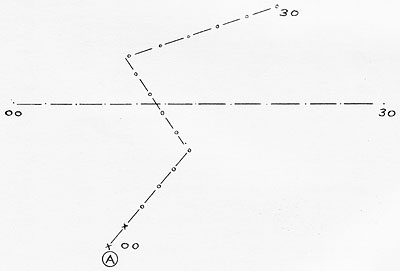
Figure A
--A-17--
--A-18--
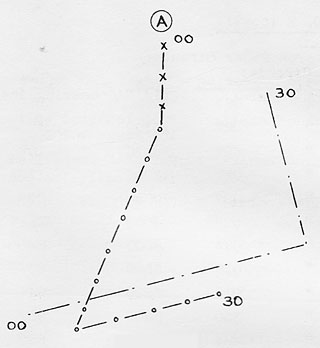
Figure B
Evaluator's Circuit:
| 01 |
Conn- Combat: |
Raid "A" true bearing 027 range 16500 |
| 04 |
Conn- Combat: |
Raid "A" course 180 speed 30 |
| 05 |
Conn- Combat: |
Smoke on horizon reported by lookouts is evidently Raid "A"' |
| 06 |
Conn- Combat: |
Lookouts have sighted Raid "A" |
| 06½ |
Conn- Combat: |
Raid "A" has changed course to the right to 210 speed still 30 |
| 07 |
Conn- Combat: |
Lookouts have identified Raid "A" as the Mobile. |
| 15 |
Combat- Conn: |
Range and bearing on the Mobile? |
| 15½ |
Combat- Conn: |
Mobile true bearing 248 range 7500 |
| 22 |
Conn- Combat: |
Mobile has changed course to the left to speed still 30 |
| 26 |
Conn- Combat: |
Ship sighted by lookouts is the Mobile, bearing 219, range 11800 |
| 30 |
END OF PROBLEM. |
--A-19--
PROBLEM NO. 2 (cont).
Surface Search Radar Circuit;
| TIME |
RAID |
BEARING |
RANGE |
|
TIME |
RAID |
BEARING |
RANGE |
| 00 |
A |
027 |
16500 |
|
16 |
A |
244 |
9000 |
| 01 |
" |
027 |
15100 |
|
17 |
" |
241 |
10500 |
| 022 |
" |
027 |
13000 |
|
182 |
" |
238 |
12800 |
| 03 |
" |
027 |
12200 |
|
19 |
" |
237 |
13600 |
| 04 |
" |
027 |
10750 |
|
20 |
" |
236 |
14700 |
| 05 |
" |
028 |
9500 |
|
21 |
" |
233 |
14200 |
| 06 |
" |
023 |
8000 |
|
22 |
" |
231 |
13550 |
| 07 |
" |
018 |
6550 |
|
23 |
" |
227 |
12900 |
| 08 |
" |
010 |
5200 |
|
24 |
" |
223 |
12300 |
| 091 |
" |
350 |
3800 |
|
25 |
" |
219 |
11800 |
| 10 |
" |
334 |
3200 |
|
262 |
" |
212 |
11100 |
| 11 |
" |
305 |
3050 |
|
27 |
" |
210 |
10950 |
| 12 |
" |
279 |
3650 |
|
28 |
" |
205 |
10650 |
| 13 |
" |
264 |
4750 |
|
29 |
" |
200 |
10400 |
| 14 |
" |
254 |
6100 |
|
30 |
" |
194 |
10300 |
| 15 |
" |
248 |
7500 |
|
|
|
|
|
PROBLEM NO. 3.
The Tactical Situation:
You have just left Norfolk. Friendly contacts are expected. The visibility is four miles.
The following sound powered phone circuits are manned: Evaluator's circuit, Lookout circuit,
Surface search radar circuit. Own ship's course 040 speed 20 knots. Suggested plotting
scale 1000 yards = 1 inch. This problem will develop as illustrated in Figure C.
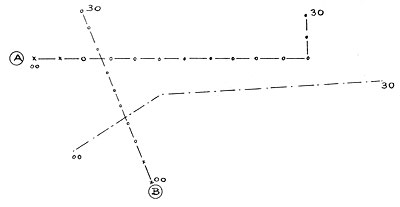
Figure C
--A-20--
PROBLEM NO. 3 (cont).
Evaluator's Circuit:
|




